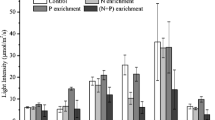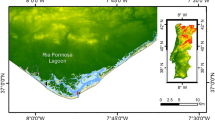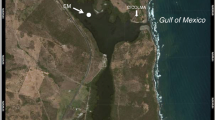Abstract
Phosphorus (P) limitation has been regarded as the rule in freshwater systems and the basis for phytoplankton growth management. We hypothesised that P would be the limiting nutrient for phytoplankton growth in Grahamstown Dam, a shallow, mesotrophic reservoir, across different seasons and on different experimental time scales. Seven fully factorial microcosm assays with additions of nitrogen (N) and P were conducted in situ during different seasons. The influence of longer experimental duration was examined in two 18-day mesocosm assays. Additions of N and P in combination evoked significantly higher phytoplankton biomass and biovolumes of individual algal genera compared with controls and other treatments in both types of experiment. There were some significant responses to P additions in the microcosm assays in winter. Some genera first responded to combined P and N addition and then to P only addition during the mesocoms assays. Our results show that P was not the limiting nutrient across all seasons but that phytoplankton was mostly co-limited by N and P. A longer experimental time scale did not change this outcome at the biomass level. This implies that input of N as well as of P should be considered in the management of phytoplankton growth.







Similar content being viewed by others
References
APHA (ed.). 1995. Standard Methods for the Examination of Water and Wastewater, 19th edn. American Public Health Association/American Water Works Association/Water Pollution Control Federation, Washington, DC.
Bergström, A. K., A. Jonsson & M. Jansson, 2008. Phytoplankton responses to nitrogen and phosphorus enrichment in unproductive Swedish lakes along a gradient of atmospheric nitrogen deposition. Aquatic Biology 4: 55–64.
Bowling, L. C., 1994. Occurrence and possible causes of a severe cyanobacterial bloom in Lake Cargelligo, New South Wales. Australian Journal of Marine and Freshwater Research 45: 737–745.
Burch, M. D., F. L. Harvey, P. D. Baker & G. Jones, 2006. National protocol for the monitoring of cyanobacteria and their toxins in surface fresh waters Draft V6.0.
Burger, D. F., D. P. Hamilton, J. A. Hall & E. F. Ryan, 2007. Phytoplankton nutrient limitation in a polymictic eutrophic lake: community versus species-specific responses. Archiv für Hydrobiologie 169(1): 57–68.
Carignan, R. & D. Planas, 1994. Recognition of nutrient and light limitation in turbid mixed layers: three approaches compared in the Paraná floodplain (Argentina). Limnology and Oceanography 39(3): 580–596.
Carpenter, S. R., 1996. Microcosm experiments have limited relevance for community and ecosystem ecology. Ecology 77(3): 677–680.
Cole, B. & B. Williams, 2011. Grahamstown Dam Water Quality & Aquatic Ecological Functioning. A Compilation of Scientific and Adaptive Management Studies. Hunter Water Corporation, Newcastle, NSW.
Danger, M., T. Daufresne, F. Lucas, S. Pissard & G. Lacroix, 2008. Does Liebig’s law of the minimum scale up from species to communities? Oikos 117(11): 1741–1751.
De Tezanos Pinto, P. & E. Litchman, 2010. Interactive effects of N:P ratios and light on nitrogen-fixer abundance. Oikos 119: 567–575.
Dzialowski, A. R., S. H. Wang, N. C. Lim, W. W. Spotts & D. G. Huggins, 2005. Nutrient limitation of phytoplankton growth in central plains reservoirs, USA. Journal of Plankton Research 27(6): 587–595.
Eixler, S., U. Karstens & U. Selig, 2006. Phosphorus storage in Chlorella vulgaris (Trebouxiophyceae, Chlorophyta) cells and its dependence on phosphate supply. Phycologia 45: 53–60.
Elser, J. J., M. E. Bracken, E. E. Cleland, D. S. Gruner, W. S. Harpole, H. Hillebrand, J. T. Ngai, E. W. Seabloom, J. B. Shurin & J. E. Smith, 2007. Global analysis of nitrogen and phosphorus limitation of primary producers in freshwater, marine and terrestrial ecosystems. Ecology Letters 10: 1135–1142.
Entwistle, T. J., J. A. Sonneman & S. H. Lewis, 1997. Freshwater Algae in Australia. A Guide to Conspicuous Genera. Sainty and Associates, Sydney.
Gregor, J. & B. Maršálek, 2004. Freshwater phytoplankton quantification by chlorophyll a: a comparative study of in vitro, in vivo and in situ methods. Water Research 38: 517–522.
Harpole, W. S., J. T. Ngai, E. E. Cleland, E. W. Seabloom, E. T. Borer, M. E. Bracken, J. J. Elser, D. S. Gruner, H. Hillebrand, J. B. Shurin & J. E. Smith, 2011. Nutrient co-limitation of primary producer communities. Ecology Letters 14: 852–862.
Hyenstrand, P., E. Rydin, M. Gunnerhed, J. Linder & P. Blomqvist, 2001. Response of the cyanobacterium Gloeotrichia echinulata to iron and boron additions – an experiment from Lake Erken. Freshwater Biology 46: 735–741.
James, C., J. Fisher & B. Moss, 2003. Nitrogen driven lakes: the Shropshire and Cheshire Meres? Archiv für Hydrobiologie 158: 249–266.
Jeppesen, E., M. Søndergaard, J. P. Jensen, K. E. Havens, O. Anneville, L. Carvalho, M. F. Coveney, R. Deneke, M. T. Dokulil, B. Foy, D. Gerdeaux, S. E. Hampton, S. Hilt, K. Kangur, J. Kohler, E. H. H. R. Lammens, T. L. Lauridsen, M. Manca, M. R. Miracle, B. Moss, P. Noges, G. Persson, G. Phillips, R. Portielje, S. Romo, C. L. Schelske, D. Straile, I. Tatrai, E. Willén & M. Winder, 2005. Lake responses to reduced nutrient loading – an analysis of contemporary long-term data from 35 case studies. Freshwater Biology 50: 1747–1771
Lewis, W. M. & W. A. Wurtsbaugh, 2008. Control of lacustrine phytoplankton by nutrients: erosion of the phosphorus paradigm. Interational Review of Hydrobiology 93(4): 446–465.
Litchman, E., 2000. Growth rates of phytoplankton under fluctuating light. Freshwater Biology 44: 223–235.
Lürling, M., F. Eshetu, E. J. Faassen, S. Kosten, V. L. M. Huszar, 2013. Comparison of cyanobacterial and green algal growth rates at different temperatures. Freshwater Biology 58(3): 552–559.
Moon, J. B. & H. J. Carrick, 2007. Seasonal variation of phytoplankton nutrient limitation in Lake Erie. Aquatic Microbial Ecology 48: 61–71.
Ogbebo, F. E., M. S. Evans, M. J. Waiser, V. P. Tumber & J. J. Keating, 2009. Nutrient limitation of phytoplankton growth in Arctic lakes of the lower Mackenzie River Basin, northern Canada. Canadian Journal of Fisheries and Aquatic Sciences 66(2): 247–260.
Olenina, I., S. Hajdu, L. Edler, A. Andersson, N. Wasmund, S. Busch, J. Göbel, S. Gromisz, S. Huseby, M. Huttunen, A. Jaanus, P. Kokkonen, I. Ledaine & E. Niemkiewicz, 2005. Biovolumes and size-classes of phytoplankton in the Baltic Sea. HELCOM Baltic Sea Environment Proceedings 106: 1–144.
Piehler, M. F., J. Dyble, P. H. Moisander, A. D. Chapman, J. Hendrickson & H. W. Paerl, 2009. Interactions between nitrogen dynamics and the phytoplankton community in Lake George, Florida, USA. Lake and Reservoir Management 25: 1–14.
Prescott, G. W., 1978. How to Know the Freshwater Algae, 3rd edn. Wm.C. Brown Company Publishers, Dubuque, IA.
Qin, B., G. Zhu, G. Gao, Y. Zhang, W. Li, H. W. Paerl & W. W. Carmichael, 2010. A drinking water crisis in Lake Taihu, China: linkage to climatic variability and lake management. Environmental Management 45: 105–112.
Quiblier, C., C. Leboulanger, S. Sané & P. Dufour, 2008. Phytoplankton growth control and risk of cyanobacterial blooms in the lower senegal river delta region. Water Research 42: 1023–1034.
Saito, M. A., T. J. Goepfert & J. T. Ritt, 2008. Some thoughts on the concept of colimitation: three definitions and the importance of bioavailability. Limnology and Oceanography 53(1): 276–290.
Schabhüttl, S., P. Hingsamer, G. Weigelhofer, T. Hein, A. Weigert & M. Striebel, 2013. Temperature and species richness effects in phytoplankton communities. Oecologia 171: 527–536.
Schindler, D. W., 1977. Evolution of phosphorus limitation in lakes. Science 195(4275): 260–262.
Schindler, D. W., 1998. Replication versus realism: need for ecosystem-scale experiments. Ecosystems 1: 323–334.
Schindler, D. W., R. E. Hecky, D. L. Findlay, M. P. Stainton, B. R. Parker, M. J. Paterson, K. G. Beaty, M. Lyng & S. E. M. Kasian, 2008. Eutrophication of lakes cannot be controlled by reducing nitrogen input: results of a 37-year whole-ecosystem experiment. Proceedings of the National Academy of Sciences of the United States of America 105(32): 11254–11258.
Spivak, A. C., M. J. Vanni & E. M. Mette, 2011. Moving on up: can results from simple aquatic mesocosm experiments be applied across broad spatial scales? Freshwater Biology 56: 279–291.
Sterner, R. W., 2008. On the phosphorus limitation paradigm for lakes. International Review of Hydrobiology 93(4–5): 433–445.
Streble, H. & D. Krauter, 2008. Das Leben im Wassertropfen, 10th edn. Franckh-Kosmos Verlags-GmbH & Co. KG, Stuttgart.
Vrede, T., A. Ballantyne, C. Mille-Lindblom, G. Algesten, C. Gudasz, S. Lindahl & A. K. Brunberg, 2009. Effects of N:P loading ratios on phytoplankton community composition, primary production and N fixation in a eutrophic lake. Freshwater Biology 54: 331–344.
Willén, E., 2001. Phytoplankton and water quality characterization: experiences from the Swedish Large Lakes Mälaren, Hjälmaren, Vättern and Vänern. Ambio 30: 529–538.
Xu, S., B. Huang, Z. B. Wei, J. Luo, A. J. Miao & L.-Y.Yang, 2013. Seasonal variation of phytoplankton nutrient limitation in Lake Taihu, China: a monthly study from year 2011 to 2012. Ecotoxicology and Environmental Safety 94: 190–196.
Acknowledgments
We would like to thank Hunter Water for funding this project under the Grahamstown Dam Adaptive Management Strategy, in particular Bruce Cole for management of the project and Ian Graham, Stuart Bailey, Jim Carter, Greg Mason and Paul for their help with boat operations and sampling. Further, we are grateful for the assistance of James Hitchcock and Martin Pfeil in the field and we owe Dr Darren Baldwin thanks for useful comments on this study.
Author information
Authors and Affiliations
Corresponding author
Additional information
Handling editor: David Philip Hamilton
Electronic supplementary material
Below is the link to the electronic supplementary material.
Rights and permissions
About this article
Cite this article
Müller, S., Mitrovic, S.M. Phytoplankton co-limitation by nitrogen and phosphorus in a shallow reservoir: progressing from the phosphorus limitation paradigm. Hydrobiologia 744, 255–269 (2015). https://doi.org/10.1007/s10750-014-2082-3
Received:
Revised:
Accepted:
Published:
Issue Date:
DOI: https://doi.org/10.1007/s10750-014-2082-3




